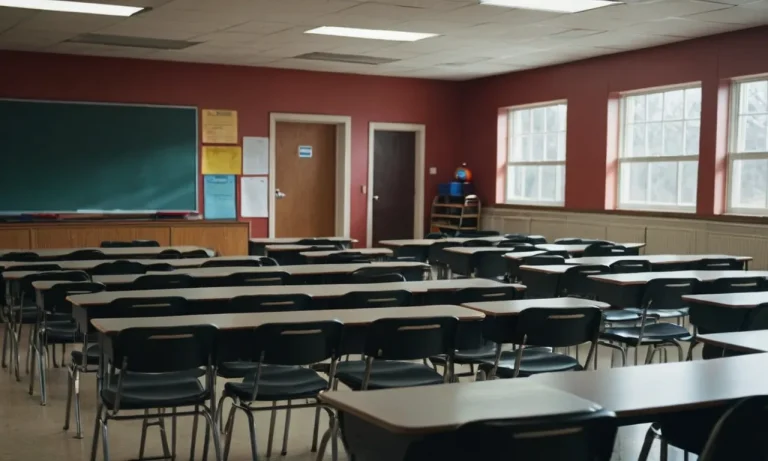In the digital age, privacy concerns have become increasingly prevalent, especially when it comes to the devices our children use for educational purposes. As schools embrace technology and provide students with Chromebooks, a burning question arises: Do these devices have trackers installed, potentially compromising the privacy of our young learners?
If you’re short on time, here’s a quick answer to your question: Yes, school Chromebooks often have tracking software installed to monitor student activity and ensure compliance with school policies. However, the extent of tracking and the specific features vary depending on the school district and their chosen software solutions.
In this comprehensive article, we’ll delve into the world of school Chromebook tracking, exploring the reasons behind its implementation, the types of tracking software used, and the potential implications for student privacy.
We’ll also provide insights into the measures schools take to protect student data and offer tips for parents and students to safeguard their online privacy.
Why Do Schools Use Tracking Software on Chromebooks?
In today’s digital age, schools have embraced technology as an integral part of the learning experience. One aspect of this integration is the use of Chromebooks, which have become increasingly popular in educational settings due to their cost-effectiveness, ease of management, and integration with Google’s suite of productivity tools.
However, many parents and students are concerned about the use of tracking software on these devices. So, why do schools feel the need to monitor student activity on Chromebooks?
Monitoring Student Activity
One of the primary reasons schools use tracking software is to monitor student activity on Chromebooks. By monitoring their online behavior, schools can ensure that students are using the devices for educational purposes and not engaging in activities that could be distracting or harmful.
According to a report by Education Week, approximately 80% of teachers and administrators believe that monitoring student online activity is necessary to protect students and ensure a safe learning environment.
Ensuring Compliance with Policies
Schools also use tracking software to ensure compliance with school policies and regulations. Many schools have strict policies regarding internet usage, cyberbullying, and access to inappropriate content.
By monitoring student activity on Chromebooks, schools can identify instances where these policies are being violated and take appropriate action. This not only helps maintain a positive learning environment but also protects the school from potential legal liabilities.
Protecting Students from Harmful Content
Another crucial reason for using tracking software is to protect students from harmful or inappropriate content online. The internet is a vast and often unregulated space, and students can inadvertently stumble upon content that is not suitable for their age or that could potentially harm them.
By monitoring their online activity, schools can detect and block access to such content, ensuring a safer browsing experience for students. According to a study by Common Sense Media, 53% of children aged 8-12 have encountered online content that made them feel uncomfortable or scared.
Facilitating Remote Learning
The COVID-19 pandemic has accelerated the adoption of remote learning, with many schools relying on Chromebooks and online platforms to deliver education. In this context, tracking software becomes even more crucial, as it allows schools to monitor student engagement, attendance, and progress during remote learning sessions.
Additionally, it helps ensure that students are using their devices appropriately and not engaging in unauthorized activities during class time. According to a survey by Education Week, 77% of educators believe that monitoring student online activity is essential for supporting remote learning.
While the use of tracking software on school Chromebooks raises valid concerns about privacy and data security, it’s important to recognize the potential benefits and the efforts schools make to strike a balance between student safety, educational integrity, and individual privacy.
As technology continues to evolve, schools will need to adapt their policies and practices to address these concerns while maintaining a safe and productive learning environment for all students.
Types of Tracking Software Used on School Chromebooks
School districts employ various tracking software on Chromebooks issued to students to ensure online safety, monitor usage, and maintain control over these devices. The extent of tracking varies across districts, but commonly used tools include:
Web Filtering and Content Monitoring
Web filtering software blocks access to inappropriate or harmful websites, preventing students from accessing explicit content, hate speech, or sites promoting violence or illegal activities. Content monitoring tools scan emails, documents, and online activity for potentially concerning language or behavior, alerting school administrators.
Popular web filtering solutions used in schools include Securly, GoGuardian, and Lightspeed Systems.
Keystroke Logging and Screen Capture
Some tracking software can log keystrokes and capture screenshots on school-issued devices. This allows administrators to monitor students’ online activities and ensure they aren’t engaging in cyberbullying, sharing inappropriate content, or accessing restricted materials.
However, this level of monitoring raises privacy concerns and is often controversial. According to a report by the Electronic Frontier Foundation, around 88% of teachers are uncomfortable with such extensive monitoring.
Location Tracking
Many school districts enable location tracking on Chromebooks to keep tabs on the devices’ whereabouts. This can help recover lost or stolen devices and ensure students are using them responsibly during school hours.
According to GovTech, over 60% of schools use some form of location tracking on student devices.
Activity Monitoring and Reporting
Tracking software can monitor and log students’ online activities, including websites visited, search histories, and app usage. This data is then compiled into reports for administrators and teachers to review.
While intended to promote responsible device use, some argue that this level of surveillance infringes on students’ privacy rights. According to a report by EdWeek, many parents and advocacy groups have raised concerns about the potential misuse of such data.
Ultimately, while tracking software on school Chromebooks aims to protect students and ensure responsible device use, it’s crucial for districts to strike a balance between safety and privacy. Clear policies, transparency, and open communication with parents and students can help navigate this delicate issue.
Don’t forget, a little humor can go a long way in diffusing tense situations! 😄
Privacy Concerns and Potential Implications
Student Privacy Rights
The use of school-issued Chromebooks has sparked a heated debate surrounding student privacy rights. While these devices aim to facilitate learning and provide equal access to educational resources, they also raise concerns about potential violations of privacy.
According to a Student Privacy Compass report, 49% of parents express worry about their children’s data being collected and shared without consent. The Family Educational Rights and Privacy Act (FERPA) aims to protect student records, but the extent to which it covers data collected through Chromebooks remains a gray area.
Data Breaches and Cybersecurity Risks
Another major concern is the potential for data breaches and cybersecurity risks associated with school-issued devices. A report by the K-12 Cybersecurity Resource Center revealed that in 2022 alone, there were 📈 348 publicly disclosed cybersecurity incidents affecting K-12 schools across the United States.
😨 These incidents not only compromise sensitive student data but also disrupt the learning process. Cybercriminals are increasingly targeting educational institutions, making it crucial to implement robust security measures to safeguard Chromebooks and the data they contain.
Psychological Impact on Students
Beyond privacy and security concerns, the use of school-issued Chromebooks can also have psychological implications for students. A study by the American Psychological Association suggests that constant monitoring and surveillance can lead to increased stress, anxiety, and a feeling of being constantly watched.
😟 This can negatively impact students’ emotional well-being and hinder their ability to learn and thrive in a healthy educational environment. It’s essential to strike a balance between necessary monitoring and respecting students’ privacy and autonomy.
Balancing Safety and Privacy
Addressing the privacy concerns surrounding school-issued Chromebooks requires a delicate balance between ensuring student safety and protecting their privacy. Schools must implement robust cybersecurity measures, such as encryption, firewalls, and regular software updates, to safeguard against data breaches and unauthorized access.
At the same time, they should clearly communicate their data collection practices, obtain appropriate consent, and limit data collection to only what is necessary for educational purposes. 👍 By fostering open dialogues with students, parents, and privacy advocates, schools can work towards finding a reasonable middle ground that prioritizes both safety and privacy.
Best Practices for Schools and Parents
Transparent Communication and Consent
Schools should prioritize open and transparent communication with parents and students regarding the use of Chromebooks and any potential tracking or monitoring measures in place. Obtaining informed consent from parents and guardians is crucial, as it fosters trust and ensures they are aware of how their children’s data is being handled.
This process should involve providing clear and concise information about the specific purposes, scope, and methods of tracking or monitoring, as well as outlining the measures taken to safeguard privacy and data security.
According to a survey by the National Center for Education Statistics, over 60% of parents expressed concerns about their children’s online privacy and data protection in educational settings. By addressing these concerns proactively, schools can build a strong foundation of trust and collaboration with families.
Implementing Robust Data Protection Measures
To ensure the responsible and ethical use of Chromebooks, schools must implement robust data protection measures that align with industry best practices and relevant privacy laws and regulations. This includes implementing strong encryption protocols, access controls, and data minimization strategies to limit the collection and retention of personal information to only what is necessary for educational purposes.
Additionally, schools should conduct regular risk assessments, security audits, and penetration testing to identify and address potential vulnerabilities. The Federal Trade Commission’s COPPA guidelines provide a valuable framework for protecting the privacy of children under the age of 13, which is particularly relevant in educational settings.
By adopting a comprehensive data protection strategy, schools can demonstrate their commitment to safeguarding student privacy and building trust with stakeholders.
Educating Students on Digital Citizenship
In addition to implementing technical measures, schools should prioritize educating students on the principles of digital citizenship and responsible technology use. This can include teaching them about online safety, cyberbullying prevention, digital footprint management, and the importance of protecting personal information.
By fostering a culture of digital responsibility, students can better understand the implications of their online activities and develop the skills necessary to navigate the digital world safely and ethically.
According to a study by Education Week, over 75% of teachers believe that digital citizenship education is essential for student success in the 21st century. By empowering students with knowledge and critical thinking skills, schools can cultivate a generation of responsible digital citizens who can make informed decisions about their online privacy and security.
Encouraging Open Dialogue and Feedback
Finally, schools should foster an environment that encourages open dialogue and feedback from parents, students, and other stakeholders regarding the use of Chromebooks and any associated tracking or monitoring practices.
This can be achieved through regular surveys, town hall meetings, or dedicated feedback channels. By actively seeking input and addressing concerns, schools can continually refine their policies and practices to better align with the evolving needs and expectations of their communities.
Additionally, schools can share success stories and best practices with other educational institutions, fostering a collaborative approach to addressing the challenges of technology integration and privacy protection in educational settings.
The Consortium for School Networking (CoSN) is an excellent resource for schools seeking guidance and networking opportunities in this area.
Conclusion
The use of tracking software on school Chromebooks is a complex issue that requires careful consideration and a balanced approach. While schools have legitimate reasons for implementing such measures, including ensuring student safety and compliance with policies, it is crucial to address the potential privacy concerns and implications.
By fostering open communication, implementing robust data protection measures, and educating students on digital citizenship, schools can strike a balance between safety and privacy. Parents, too, play a vital role in understanding the tracking practices in place and engaging in constructive dialogue with school authorities to safeguard their children’s privacy rights.
Ultimately, the responsible use of tracking software on school Chromebooks should prioritize transparency, consent, and the well-being of students. By working together, schools, parents, and students can navigate the digital landscape while upholding the principles of privacy and fostering a safe and conducive learning environment.






